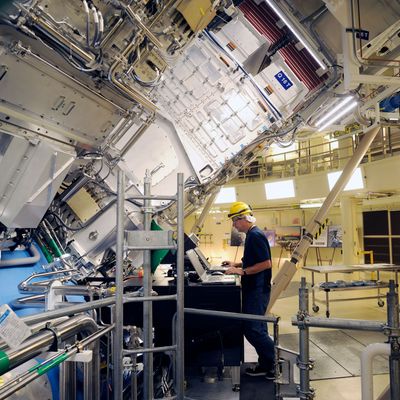
Scientists at the U.S. Department of Energy’s Lawrence Livermore National Laboratory in California have reportedly made a major breakthrough in emulating the power of the sun. Researchers were apparently able to conduct, for the first time, a successful nuclear-fusion experiment at the lab’s National Ignition Facility that produced more energy than it consumed — a long-sought net-energy gain, which scientists have been attempting to achieve for decades. At a press conference on Tuesday, Energy Secretary Jennifer Granholm called it “one of the most impressive scientific feats of the 21st century,” while White House science adviser Arati Prabhakar labeled it “an engineering marvel beyond belief.” Just how big of a deal is the news, and what does it mean for the multibillion-dollar pursuit of fusion as a world-changing source of renewable clean energy?
The Experiment
According to the Financial Times, LLNL scientists used the world’s largest laser to bombard a tiny pellet of hydrogen, creating a fusion reaction that “produced about 2.5 megajoules of energy, which was about 120 per cent of the 2.1 megajoules of energy in the lasers, the people with knowledge of the results said, adding that the data was still being analysed.”
The facility’s reactor is a laser-based inertial-confinement fusion device as opposed to the magnetic-confinement fusion devices being used in most fusion research.
Responding to the breakthrough, plasma physicist Dr. Arthur Turrell told FT, “If this is confirmed, we are witnessing a moment of history … Scientists have struggled to show that fusion can release more energy than is put in since the 1950s, and the researchers at Lawrence Livermore seem to have finally and absolutely smashed this decades-old goal.”
Queen’s University Belfast physicist Gianluca Sarri, speaking with New Scientist about the news, said the results, if verified, represent a major milestone. “Scientifically, this is the first time that they showed that this is possible,” he said. “From theory, they knew that it should happen, but it was never seen in real life experimentally.”
Don’t expect commercial fusion power anytime soon.
Scientists and energy-industry experts appear to be universally excited about the breakthrough, but many are also stressing that it doesn’t mean we’ll be building nuclear-fusion power plants — or have Mr. Fusion powering our flying cars — anytime soon.
As the Washington Post noted in its report on the experiment, the scientific and engineering hurdles ahead remain enormous:
Creating the net energy gain required engagement of one of the largest lasers in the world, and the resources needed to recreate the reaction on the scale required to make fusion practical for energy production are immense. More importantly, engineers have yet to develop machinery capable of affordably turning that reaction into electricity that can be practically deployed to the power grid.
Building devices that are large enough to create fusion power at scale, scientists say, would require materials that are extraordinarily difficult to produce. At the same time, the reaction creates neutrons that put a tremendous amount of stress on the equipment creating it, such that it can get destroyed in the process.
New Scientist also stresses that the net-energy gain was only from the experiment itself:
For a reactor to be generally useful, it would have to produce more energy than was initially put into the lasers. Inefficiencies involved in producing laser light from electricity mean that is currently not the case – Sarri estimates that if 2.1 megajoules of energy was output by the laser then NIF would have had to draw “tens” of megajoules from the electricity grid to achieve it.
Even once a reactor can offset the true energy required by the lasers, it would only be breaking even. For fusion to become a viable alternative to existing power sources, we must be able to extract a large amount of net energy.
There is also an efficiency problem, explains Bloomberg’s David Fickling:
All that atom-smashing ultimately goes to heat up a network of pipes and drive turbines — more or less the same back end as you’d find in a coal, gas or nuclear fission plant. As a result, you can immediately halve the 20% energy gain attributed to the US experiment. The energy lost to waste heat and noise in such systems means they typically have thermal efficiency of less than 50%.
And the big lasers can’t be fired very often, either:
Put simply, the breakthrough is absolutely significant and worth getting excited about — as a proof of concept. But no matter what, commercial fusion-energy production is still decades away at best and shouldn’t be thought of as some silver bullet that will soon solve the world’s energy or climate-change problems.
This post has been updated.






























